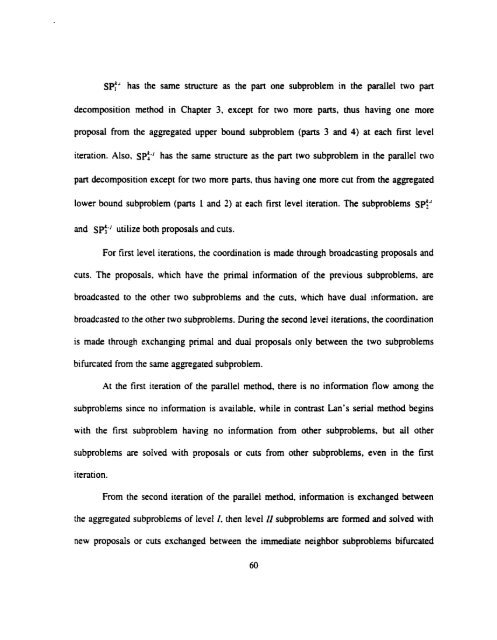X - UWSpace - University of Waterloo
X - UWSpace - University of Waterloo
X - UWSpace - University of Waterloo
Create successful ePaper yourself
Turn your PDF publications into a flip-book with our unique Google optimized e-Paper software.
SP~' has the same structure as the part one subproblem in the parallel two pari<br />
decomposition method in Chapter 3, except for two more parts. thus having one more<br />
proposal from the aggregated upper bound subproblem (parts 3 and 4) at each fint level<br />
iteration. Also. SP:.J has the same structure as the part two subproblem in the panllel two<br />
part decomposition except for two more pans, thus having one more cut from the aggregated<br />
lower bound subproblem (parts 1 and 1) at each first ievel iteration. The subproblems spi"<br />
and SP:+' utilize both proposals and cuts.<br />
For fint level i tentions, the coordination is made through broadcasting proposals and<br />
cuts. The proposais. which have the prima1 information <strong>of</strong> the previous subproblems. are<br />
broadcasted to the other two subproblems and the cuts, which have dual information, are<br />
broadcasted to the other two subproblems. During the second level iterations, the coordination<br />
is made through exchanging prima1 and duai proposals only between the two subproblems<br />
bi furcated from the same aggregated subpro blem.<br />
At the fint itention <strong>of</strong> the paralle1 method, there is no information flow among the<br />
subproblerns since no information is available. whiIe in concrast Lan's senal meihod begins<br />
with the fint subproblem having no information from other subproblems. but al1 other<br />
subproblems are solved with proposals or cuts from other subproblems, even in the first<br />
itention.<br />
From the second iteration <strong>of</strong> the parallel methoci, information is exchmged between<br />
the aggregated subproblems <strong>of</strong> level 1. then level II subproblems are formed and solved with<br />
new proposals or cuts exchanged between the immediate neighbor subproblerns bifurcated<br />
60
















